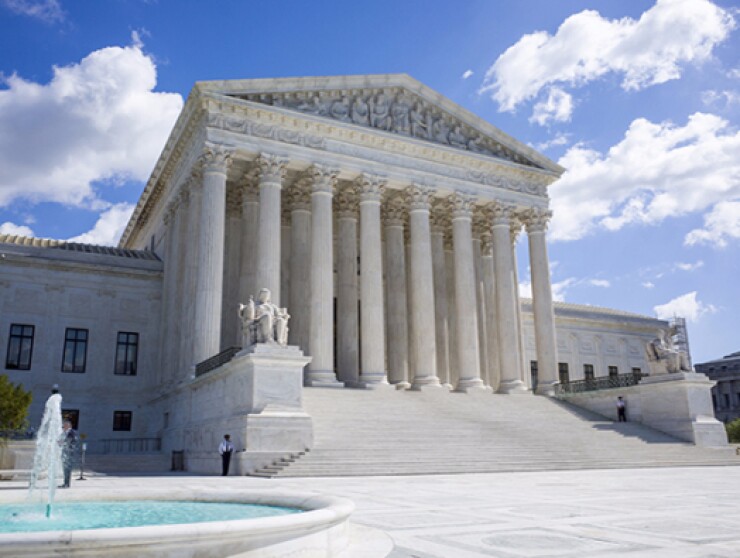
The Supreme Court heard oral arguments Tuesday in a case filed by a North Dakota truck stop that claims it has been harmed by excessive
The plaintiff in the case, Corner Post, Inc. v. Board of Governors of the Federal Reserve System, claims that it was harmed when it opened for business in 2018 and was charged
A lawyer for the truck stop argued that it should be able to challenge the Fed's rule on swipe fees as excessive, and that there should be no statute of limitations.
The justices grappled with the question of whether a newly formed company can challenge a regulatory rule if it is barred from filing a claim due to the Administrative Procedure Act's six-year statute of limitations and what remedy would be appropriate if the company was harmed.
Justice Clarence Thomas asked the first question about whether any other similar cases have been brought in which an injury occurred long after a rule has been finalized.
"Do you have any other cases like yours where the injury occurs long after the rule is adopted?" Thomas asked. "I'm more interested in the fact pattern … you have a rule that's adopted, it's final, it's been challenged. Then you go into business, you begin to operate under these rules, and you claim that's the beginning of your injury. And that restarts the statute of limitations."
Bryan Weir, a partner at Consovoy McCarthy PLLC representing the plaintiff Corner Post, argued that the clock started on the statute of limitations when the truck stop was first harmed and incurred its first swipe fee. He argued that because the truck stop hadn't even existed when the statute of limitations ran out, it has been denied its day in court and judicial review.
"The first time Corner Post was ever actually injured is the time they didn't pay the actual debit card fees that they had to pay whenever they swipe the debit card," Weir said.
Justice Elena Kagan questioned how a company can claim it has been injured when it goes into business knowing the regulatory structure that exists.
"This is kind of a revolutionary ask," Kagan said. "There's no injury in my mind when you enter a business knowing its structure and accepting rules that have been finalized."
She said that until recently the consensus view of circuit courts has been that the statute of limitations under the Administrative Procedure Act began when an agency finalized a rule, and then trade groups typically file an immediate challenge.
"What you're suggesting is a very different rule than the administrative sphere has worked under for many, many years," Kagan said.
Much of the oral arguments focused on the meaning of the word "accrues," in the APA's section 2401(a) that provides that "every civil action commenced against the United States shall be barred unless the complaint is filed within six years after the right of action first accrues."
At one point, Chief Justice John Roberts appeared to side with the plaintiff and questioned Benjamin Snyder — the assistant to the solicitor general representing the government — how the issue of the statute of limitations wasn't addressed decades ago.
"I must be missing something fundamental," Roberts said. "You have an individual or an entity that is harmed by something the government is doing. And you're saying, well, that's just too bad, you can't do anything about it because other people have six years to do something about it and maybe another person or business organization did do something about it."
But Roberts also asked how repealing the statute of limitations would work in practical terms for government agencies.
"You have, presumably, fundamental challenges that a regulatory regime starts out making decisions … and every time somebody brings a new facial challenge, they basically have to litigate that same question over again?"
Typically a company responds with a claim that it has been harmed after a regulatory enforcement action but Justice Neil Gorsuch noted that was not what happened in this case.
"You mentioned the enforcement action possibility, but why would banks challenge this rule when they benefit from it?" Gorsuch said.
To which Benjamin Schneider, a trial attorney representing the government, replied: "Banks probably think the rule should be higher."
"Right," Gorsuch responded, "If anything, they want more money!"
Justice Ketanji Brown Jackson questioned whether changing the statute of limitations would be "extraordinarily destabilizing."
"Each new company that is created in an industry can suddenly bring a challenge that might risk or undermine invalidation of the entire basis of the industry," she said. "Are you risking destabilization of the industry in this way?" she asked Weir.
The Supreme Court agreed to hear the case after the 8th Circuit Court of Appeals ruled against Corner Post last year, claiming the six-year statute of limitations expired in 2017, when the Federal Reserve's rule, known as Regulation II, was published in the Federal Register. After Regulation II went into effect, a group of merchants sued the Fed and the Supreme Court upheld the final rule, denying a petition challenging it in 2014.
Many legal experts think the high court will affirm the lower court's decision. The Federal Reserve






